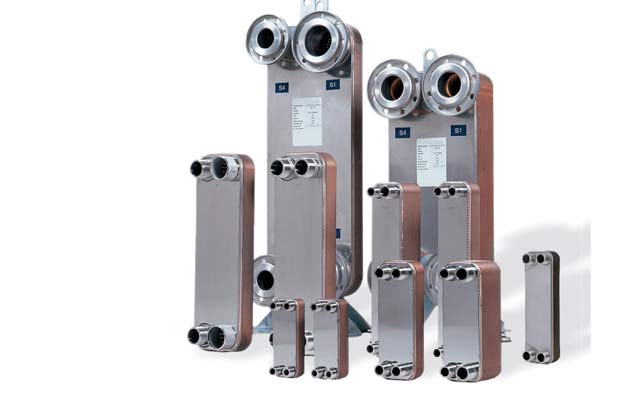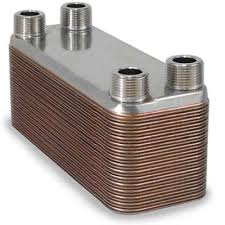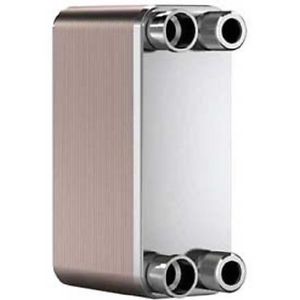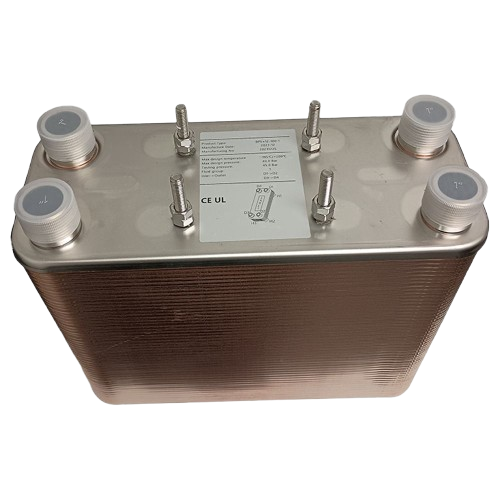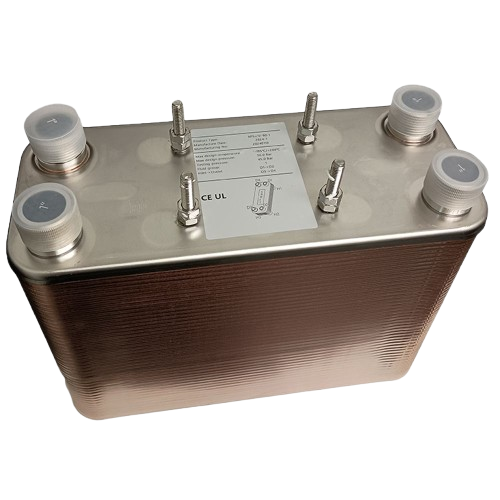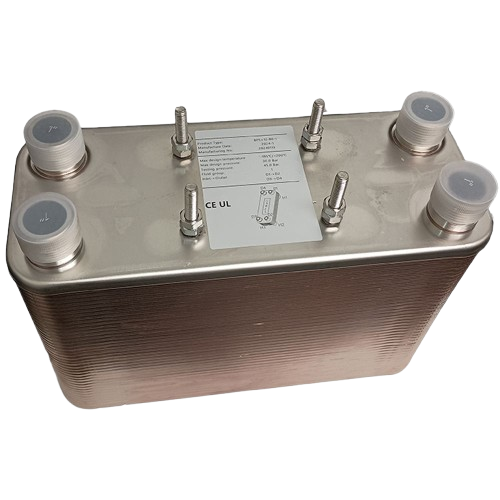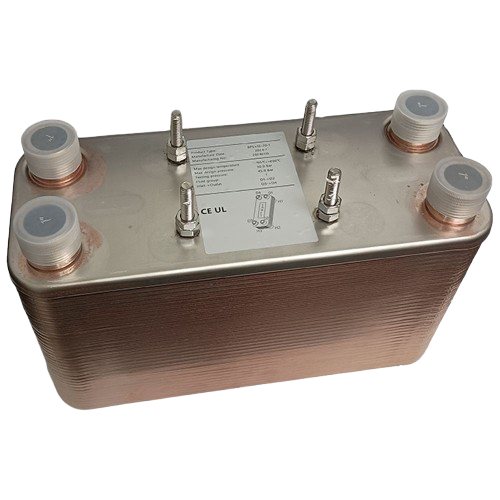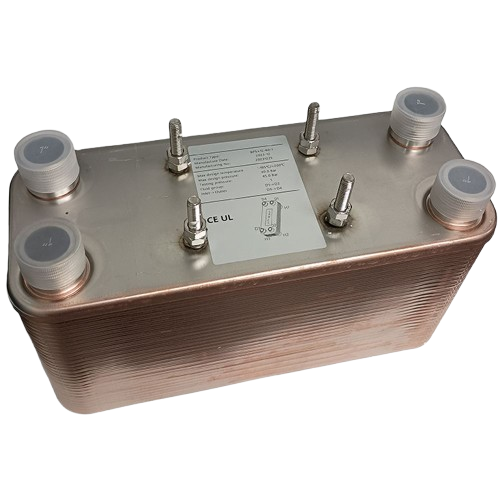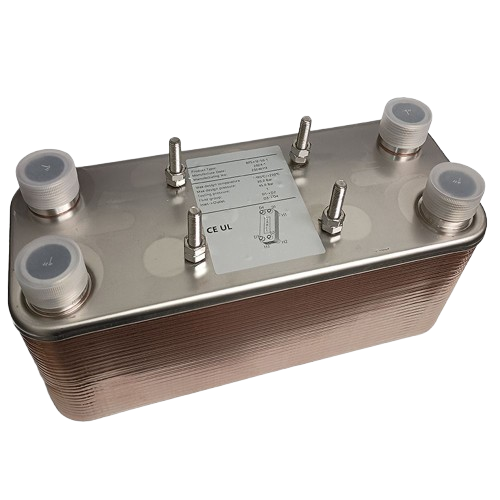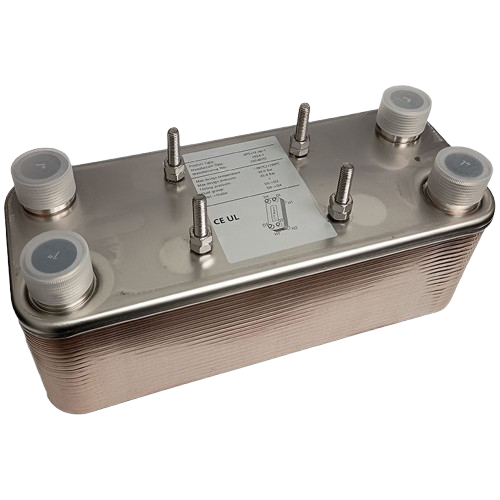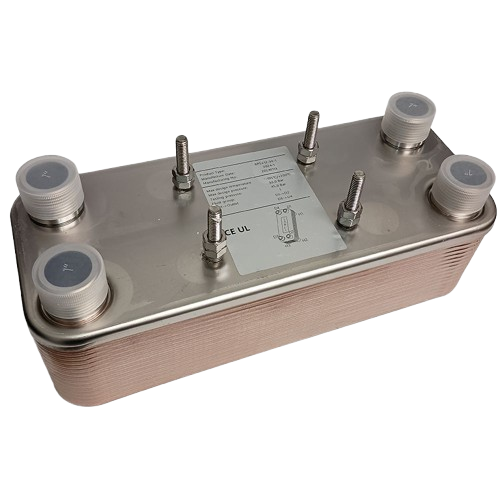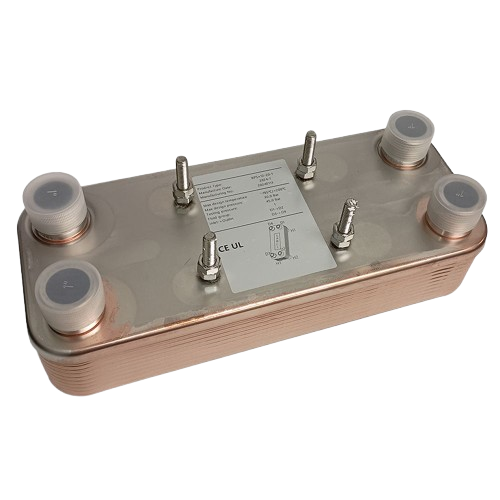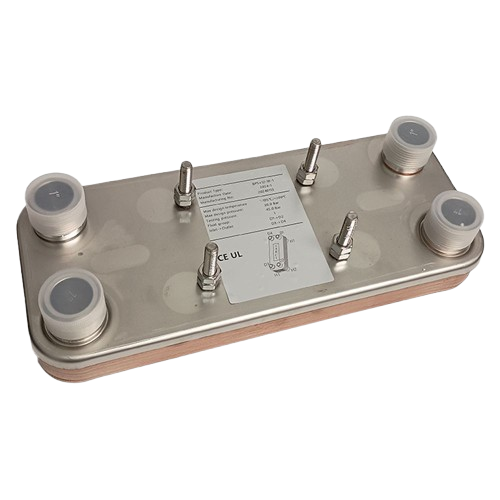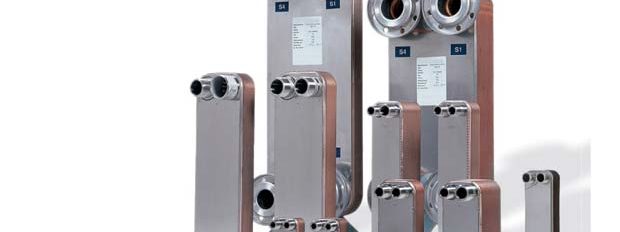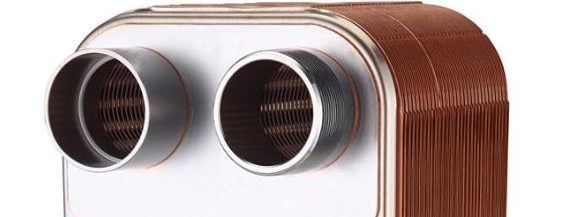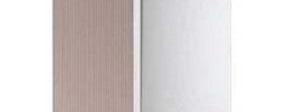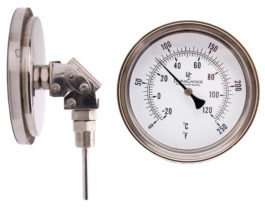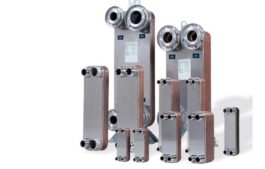Description
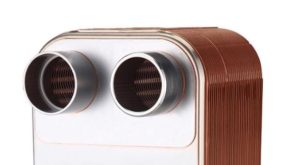 5″x12″ Brazed Plate Heat Exchangers are small, light, and compact. It does not need gaskets. Instead, it is brazed together using cooper to give a strong, compact construction.
5″x12″ Brazed Plate Heat Exchangers are small, light, and compact. It does not need gaskets. Instead, it is brazed together using cooper to give a strong, compact construction.
5″x12″ Brazed Plate Heat Exchangers are devices used to transfer heat between two or more fluids, without allowing them to mix. They are composed of a stack of corrugated metal plates, sealed with gaskets, and held together within a frame. The fluids flow in separate channels formed by the plates.
The heat transfer surface area can be increased or decreased by adding or removing plates, making 5″x12″ Brazed Plate Heat Exchangers quite versatile. These exchangers are popular due to their high heat transfer efficiency, compact size, and ease of maintenance.
Different types of metals used in 5″x12″ Brazed Plate Heat Exchangers include stainless steel, titanium, and various nickel alloys. Stainless steel is commonly used for general applications, whereas titanium offers exceptional corrosion resistance, making it suitable for highly corrosive environments. Nickel alloys are used for specific high-temperature applications.
In terms of connections, there are several types:
Gasketed Plate Heat Exchangers: These are sealed using gaskets and are suitable for most applications. They allow for easy disassembly and flexibility in plate arrangement.
Brazed Plate Heat Exchangers: In this type, the plates are brazed together, eliminating the need for gaskets. This provides higher pressure and temperature resistance, making them suitable for more demanding applications.
Welded Plate Heat Exchangers: This uses welded channels to join the plates, creating a rugged, compact design. They are often used in applications where hygiene and long-term reliability are crucial.
Each type of connection and metal used offers unique benefits and considerations based on the specific needs of the application.
5″x12″ Brazed Plate Heat Exchangers typically have flanged or threaded connection ends. These connection ends allow for easy integration into the overall fluid system. Flanged connection ends are commonly used for larger, industrial applications, providing a secure and robust attachment, while threaded connection ends are often employed in smaller-scale systems or where accessibility is limited. Finally, these connection ends enable convenient installation and maintenance of the Brazed Plate Heat Exchangers within a variety of fluid handling systems.
Compact
Also, Our BPHEs are extremely compact compared with other technologies. The footprint can be as little as one-tenth that of a shell & tube heat exchanger or half that of a gasket PHE. 5″x12″ Brazed Plate Heat Exchangers have a compact design compared to traditional heat exchangers, allowing for a high surface area-to-volume ratio. Furthermore, this compactness promotes efficient heat transfer between the fluid streams, reducing energy losses and optimizing performance.
Efficient
When gaskets or supporting equipment are not required, about 95% of the material is used to transfer heat. The highly turbulent flow also enables you to use small temperature differences efficiently.
Excellent Heat Transfer
The corrugated plates in 5″x12″ Brazed Plate Heat Exchangers create turbulent flow patterns, enhancing heat transfer efficiency. These plates maximize the contact area between the fluids, facilitating rapid and efficient heat exchange.
Reliable
In addition, the robust construction requires no gaskets, eliminating their risk of leaking. This means stable thermal and hydraulic performance, with minimal maintenance and operational downtime.
Leak-Free Design
The brazing process used in manufacturing Brazed Plate Heat Exchangers creates a robust and leak-free seal between the plates. This eliminates the risk of cross-contamination between the fluid streams, ensuring optimal heat transfer efficiency.
Low Hold-Up Volume
Brazed Plate Heat Exchangers have minimal hold-up volume, meaning that there is less fluid stagnant within the exchanger. Additionally, this results in reduced energy wastage and faster response times in heating or cooling processes.
Flexible
Also, the compact size uses space efficiently and makes system design more flexible.
Brazed Plate Heat Exchangers are Cost-effective
Also, you will save on energy, maintenance, spare parts, and installation. Also, the life cycle cost over 15-20 years can often be half that of a corresponding gasket solution.
Self-cleaning
In addition, our BPHEs are normally self-cleaning, thanks to highly turbulent flows. Moreover, in applications with a high risk of fouling or scaling, cleaning in Place is easy without disassembly.
Customized
Also, by combining plate design, materials, and connections from standard components, we keep lead times short while still maximizing output in your specific application.
Overall, the combination of compact design, excellent heat transfer capabilities, high thermal conductivity, low hold-up volume, and leak-free construction makes 5″x12″ Brazed Plate Heat Exchangers highly efficient for a wide range of heating, cooling, and refrigeration applications, leading to energy savings and improved process performance.
What are the advantages of 5″x12″ Brazed Plate Heat Exchangers?
- High heat transfer efficiency
- Compact structure
- Easy installation
- Easy Deinstallation
- Durability is based on a much higher pressure and temperature tolerance.
- Used in various industries like chemical, food and beverage, dairy, oil and gas, biofuels, biodiesel, ethanol
If these types of Heat Exchangers don’t fit your application Plate and Frame Heat Exchangers
Specifications
Below are typical specifications for a brazed plate heat exchanger:
Heat Transfer Capacity: Typically measured in kW (kiloWatts) or in Btu/h (British thermal units per hour), indicating the maximum heat transfer capacity of the heat exchanger.
Operating Pressure: Specifies the maximum allowable pressure the heat exchanger can withstand during normal operation, often measured in bars or psi (pounds per square inch).
Operating Temperature Range: Indicates the range of temperatures within which the heat exchanger can effectively and safely transfer heat, often specified with a minimum and maximum value in degrees Celsius or Fahrenheit.
Flow Rate: Indicates the maximum fluid flow rate capacity of the heat exchanger, usually measured in liters per minute or gallons per minute.
Material Construction: Specifies the materials used for the plates, connections, and any gaskets or seals. Common materials include stainless steel, copper, or nickel alloys.
Brazing Alloy: Indicates the type of brazing material used (e.g., copper, nickel, etc.) and its properties, such as melting point and tensile strength.
Dimensions: Provides the physical dimensions of the heat exchanger, including length, width, and height, as well as the number of plates within the unit.
Weight: Specifies the overall weight of the heat exchanger, which is important for installation and handling considerations.
Certification and Standards: Lists any industry standards or certifications the heat exchanger complies with, such as ASME (American Society of Mechanical Engineers) or PED (Pressure Equipment Directive).
Connection Type and Size: Specify the type (flanged, threaded, etc.) and size (diameter) of the fluid connections on the heat exchanger.
These specifications can vary based on the specific manufacturer and model of the brazed plate heat exchanger. Always refer to the product datasheet or technical documentation for precise details.
The Brazed Plate Heat exchanger is especially suitable for pressure up to 50 bar and temperatures from -196℃ to +550℃.
Q&A
Question: What is a brazed plate heat exchanger?
Answer: A brazed plate heat exchanger is a type of heat exchanger that is built with a series of thin, corrugated metal plates that are brazed together. This design enables efficient heat transfer between two fluids without those fluids coming into direct contact with each other.
Question: What are the advantages of brazed plate heat exchangers?
Answer: Brazed plate heat exchangers offer advantages such as high thermal efficiency, compact size, high resistance to pressure and temperature, and low maintenance requirements. They are also known for their ability to handle high fluid flow rates.
Question: What are the typical applications for brazed plate heat exchangers?
Answer: Brazed plate heat exchangers are used in applications such as HVAC systems, refrigeration, domestic hot water heating, industrial heating and cooling, and various industrial processes.
Question: What materials are used in the construction of brazed plate heat exchangers?
Answer: Brazed plate heat exchangers are constructed using materials such as stainless steel, copper, and nickel, depending on the specific requirements of the application. These materials offer excellent thermal conductivity and corrosion resistance.
Question: Can brazed plate heat exchangers withstand high pressures and temperatures?
Answer: Yes, brazed plate heat exchangers are designed to withstand high pressures and temperatures, making them suitable for demanding industrial applications and HVAC systems. The brazing process provides a strong bond, enabling them to handle challenging operating conditions.
Question: How do brazed plate heat exchangers compare to other types of heat exchangers?
Answer: Brazed plate heat exchangers are known for their high efficiency, compact size, and versatility compared to other heat exchanger types. They offer excellent heat transfer performance and can be easily customized for different applications.
Question: What are some key maintenance considerations for brazed plate heat exchangers?
Answer: Regular inspection for fouling, cleaning of the external surfaces, and ensuring proper fluid flow are important maintenance considerations for brazed plate heat exchangers. Additionally, checking for any signs of corrosion or leaks is crucial for long-term performance.
Question: Are brazed plate heat exchangers suitable for food and beverage industry applications?
Answer: Yes, brazed plate heat exchangers can be designed and manufactured to meet the strict hygiene and safety standards required for food and beverage processing. They are used for applications such as pasteurization, cooling, and heating of food products.
Question: Can brazed plate heat exchangers be used for high-viscosity fluids or slurries?
Answer: While brazed plate heat exchangers are primarily designed for low to medium-viscosity fluids, specialized designs can accommodate some high-viscosity fluids and slurries. It’s important to work with a supplier who can provide custom solutions for such applications.
Advantages / Disadvantages
Below are the advantages and disadvantages of brazed plate heat exchangers:
Advantages
High Thermal Efficiency: Brazed plate heat exchangers offer excellent heat transfer performance, leading to high thermal efficiency in a compact design.
Compact Size: They take up minimal space compared to other types of heat exchangers, making them ideal for applications with space constraints.
Versatility: Brazed plate heat exchangers can be easily customized for different applications and fluid types.
Resistance to Pressure and Temperature: They are capable of withstanding high pressure and temperature conditions, making them suitable for demanding industrial environments.
Low Maintenance: These heat exchangers typically require minimal maintenance, reducing long-term operational costs.
Disadvantages
Limited to Low to Medium Viscosity Fluids: Brazed plate heat exchangers may not be suitable for handling high-viscosity fluids or slurries without specialized design considerations.
Initial Cost: While they offer long-term cost savings, the initial capital investment for brazed plate heat exchangers can be higher compared to some other types of heat exchangers.
Vulnerable to Thermal Expansion: The brazing materials used have specific thermal expansion coefficients, potentially leading to metal fatigue over extended periods of operation if not designed and maintained properly.
These are general advantages and disadvantages. The specific benefits and drawbacks may vary depending on the application and operating conditions.
Applications
Brazed plate heat exchangers find versatile applications across various industries due to their compact size, efficiency, and reliable heat transfer capabilities. Some common applications include:
HVAC Systems: Brazed plate heat exchangers are frequently used in heating, ventilation, and air conditioning systems for heat recovery, domestic hot water heating, and cooling applications. Their compact design and high thermal efficiency make them ideal for HVAC systems in residential, commercial, and industrial settings.
Refrigeration: These heat exchangers are employed in refrigeration systems for evaporators and condensers, where efficient heat transfer is essential for maintaining desired temperatures and achieving energy savings. Brazed plate heat exchangers are popular in supermarkets, cold storage facilities, and industrial refrigeration units.
Industrial Process Heating and Cooling: Brazed plate heat exchangers play a crucial role in industrial processes that require precise temperature control, such as chemical processing, food and beverage production, pharmaceutical manufacturing, and power generation. They provide efficient heat transfer for various process fluids.
Renewable Energy Systems: Brazed plate heat exchangers are utilized in renewable energy applications, including solar thermal systems, geothermal heat pumps, and heat recovery units. They help optimize energy transfer in these systems, increasing their overall efficiency and sustainability.
Hydronic Heating Systems: In hydronic heating systems for residential and commercial buildings, brazed plate heat exchangers facilitate the transfer of heat between hot water sources and heating systems, ensuring efficient and effective heating throughout the space.
Oil and Gas Industry: Brazed plate heat exchangers are used in the oil and gas sector for various applications, such as heating and cooling of process fluids, heat recovery from exhaust gases, and maintaining optimal temperatures in refining processes.
Overall, brazed plate heat exchangers are favored for their flexibility, reliability, and energy efficiency, making them essential components in a wide range of applications across industries that require efficient heat exchange solutions.
Downloads
Drawings
 5″x12″ Brazed Plate Heat Exchangers are small, light, and compact. It does not need gaskets. Instead, it is brazed together using cooper to give a strong, compact construction.
5″x12″ Brazed Plate Heat Exchangers are small, light, and compact. It does not need gaskets. Instead, it is brazed together using cooper to give a strong, compact construction.
